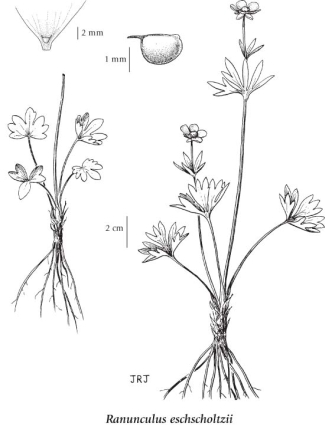Ranunculus eschscholtzii Schltdl.
subalpine buttercup (Eschscholtz's buttercup)
Ranunculaceae (Buttercup family)
Introduction to Vascular Plants
subalpine buttercup (Eschscholtz's buttercup)
Ranunculaceae (Buttercup family)
Introduction to Vascular Plants
Species Information
General:
Perennial herb from a compact, erect stem base, covered with withered leaf bases, with a cluster of fibrous roots; stems 1 to several, erect, 5-25 cm tall, usually smooth, not hollow.
Leaves:
Basal leaves persistent, kidney- or heart- or egg-shaped to broadly oblong, usually 3-parted, sometimes 3-lobed, the blades 0.5-4 cm long, 0.8-3.7 cm wide, the central segment 3-lobed to entire, the lateral segments 3- to 4-lobed, tips usually rounded, the stalks 1-8 cm long; stem leaves usually absent, sometimes 1 or 2, alternate, shorter-stalked, transitional to the unstalked, 3-lobed to -parted bracts; leaves usually smooth except fringed on margins.
Flowers:
Inflorescence a 1- to 3-flowered cyme; flower stalks stout, 2-12 cm long, smooth; receptacle smooth or sparsely soft-hairy; petals 5 to 8, distinct, yellow, broadly egg-shaped, 6-16 mm long, 4-16 mm wide, nectary on upper surface, the scale about 0.5 mm long, smooth; sepals 5, spreading, early deciduous, usually purplish-tinged, 4-8 mm long, 2-6 mm wide, usually yellow wavy-hairy; stamens (20) 40-125; pistils (20) 30-80.
Fruits:
Achenes, numerous in a cylindric to egg-shaped head 5-10 mm long, 4-7 mm wide, the achenes egg-shaped, 1.4-2 mm long, 1-1.6 mm wide, smooth or sparsely hairy, margins evident; beaks persistent, slender, 0.6-1.8 mm long, straight or somewhat curved.
Notes:
This highly variable species has sometimes been separated into either three taxa at the specific or varietal level (Brayshaw 1989, Whittemore 1997) or two taxa at the varietal level (Hitchcock et al. 1964, Douglas et al. 1991) in BC. Because large populations of plants, especially in SE BC, sometimes have plants with somewhat pointed leaves as well as the more common roundish leaf tips, some botanists have recognized them as either R. eximius or R. suksdorfii. During a study of R. suksdorfii in W North America, Fisher et al. (1979) were unable to locate the latter species in BC and reidentified BC R. suksdorfii material to R. eschscholtzii. We prefer to treat this complex, at least in BC, as one variable species.
Illustration

If more than one illustration is available for a species (e.g., separate illustrations were provided for two subspecies) then links to the separate images will be provided below. Note that individual subspecies or varietal illustrations are not always available.
Illustration Source: The Illustrated Flora of British Columbia
USDA Species Characteristics
Flower Colour:
Yellow
Blooming Period:
Early Summer
Fruit/Seed characteristics:
Colour: Brown
Present over the Summer
Source: The USDA
Ecology
Ecological Framework for Ranunculus eschscholtzii
The table below shows the species-specific information calculated from
original data (BEC database) provided by the BC Ministry of Forests and Range.
(Updated August, 2013)
The table below shows the species-specific information calculated from
original data (BEC database) provided by the BC Ministry of Forests and Range.
(Updated August, 2013)
| Site Information |
Value / Class |
||
|
Avg |
Min |
Max |
|
| Elevation
(metres) |
1915 | 16 | 2562 |
| Slope
Gradient (%) |
25 | 0 | 300 |
|
Aspect (degrees) |
203 | 0 | 360 |
| Soil
Moisture Regime (SMR) [0 - very xeric; 4 - mesic; 8 - hydric] |
4 | 0 | 8 |
| Modal
Nutrient Regime
Class |
C | ||
| #
of field plots species was recorded in: |
657 | ||
| Modal
BEC Zone Class |
ESSF | ||
|
All BEC Zones (# of stations/zone) species was recorded in |
AT(71), BAFA(76), BG(1), BWBS(1), CMA(2), CWH(1), ESSF(353), ICH(2), IMA(18), MH(7), MS(2), SBS(6), SWB(10) | ||
|
Source:
Klinkenberg 2013
|
|||
Habitat and Range
Moist meadows, heath, streambanks, shores, scree and talus slopes, and forest openings from the upper montane to alpine zones; common in S BC, less frequent northward; N to AK, YT and NT, E to SW AB and S to CO, UT, AZ, NM and CA.Status Information
| Scientific Name | Origin Status | Provincial Status | BC List (Red Blue List) | COSEWIC |
|---|---|---|---|---|
| Ranunculus eschscholtzii var. eschscholtzii | Native | S5 | Yellow | Not Listed |
| Ranunculus eschscholtzii var. eximius | Native | SNR | Blue | Not Listed |
| Ranunculus eschscholtzii var. suksdorfii | Native | S4 | Yellow | Not Listed |
BC Ministry of Environment: BC Species and Ecosystems Explorer.
Synonyms
Synonyms and Alternate Names:
Ranunculus eschscholtzii var. alpinus (S. Watson) C.L. Hitchc.
Ranunculus eschscholtzii var. eschscholtzii Schltdl.
Ranunculus eschscholtzii var. eximius (Greene) L.D. Benson
Ranunculus eximius Greene